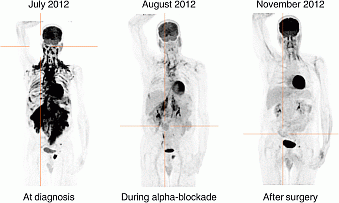ECE2013 Poster Presentations Clinical case reports – Pituitary/Adrenal (57 abstracts)
Case report: chronic adrenergic stimulation induces brown adipose tissue differentiation in visceral adipose tissue
Esben Søndergaard , Lars C Gormsen , Steen B Pedersen , Peer Christiansen , Søren Nielsen , Per L Poulsen & Niels Jessen
Aarhus University Hospital, Aarhus, Denmark.
Introduction: The presence of brown adipose tissue (BAT) in humans has recently been demonstrated by histology and positron emission tomography (PET). In previous reports, BAT in adults is primarily confined to the upper chest and neck. Here, we report a case of massive BAT infiltration of the visceral adipose tissue in a patient with catecholamine secreting paraganglioma.
Methods: The patient was evaluated with [18F]-FDG PET/CT at three occasions: pre-therapy, during α-blockade and postoperatively. During surgery, biopsies of visceral and subcutaneous adipose tissue were obtained. Histological specimens were evaluated for BAT and uncoupling protein 1 (UCP-1) gene expression was verified by QPCR, WB and immunohistochemistry. Resting energy expenditure was measured with indirect calorimetry.
Results: At diagnosis, BAT glucose uptake assessed by FDG PET was massively increased (see figure). FDG uptake was confined to known locations for BAT with additional uptake in the visceral adipose tissue. No excess activity was observed in subcutaneous adipose tissue. Histological examination revealed areas of BAT in the visceral adipose tissue with ~200-fold greater UCP-1 gene expression compared to subcutaneous adipose tissue. Owing to increased thermogenesis, resting energy expenditure was 15 188 kJ/day at diagnosis with a decrease to 8368 kJ/day after surgery. During α-adrenergic receptor-blockade, FDG uptake was decreased (see figure). After surgical removal of the tumor, BAT FDG uptake returned to normal (see figure). Normetanephrine level was greatly increased at diagnosis, with normalization after surgery (diagnosis: 3318 ng/l; post-surgery: 132 ng/l (<200 ng/l)).
Conclusion: In this case report, chronic adrenergic stimulation increased BAT differentiation and activity in visceral adipose tissue. Stimulation of adrenergic receptor signaling in BAT progenitor cells may have promising perspectives for future treatment of obesity and type 2 diabetes.

Figure 1




